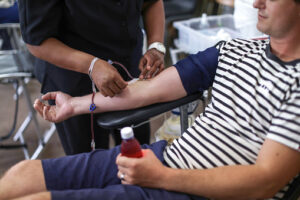In 2015, the U.S. FDA revised guidance for blood donor deferral of men who have sex with men (MSM) from an indefinite to a 12-month deferral; in April of 2020, the deferral was shortened to 3 months. In order to determine if the change from indefinite to a 12-month deferral led to an increase in the risk of transfusion-transmitted HIV, the U.S. Transfusion-Transmissible Infections Monitoring System (TTIMS) screened first-time blood donors at four major collection organizations for HIV. During the 15 months leading up to the deferral change and approximately 24 months after implementation, over 4.8 million donations were screened. HIV incidence in first-time blood donors was similar both before and after the deferral policy change: 7.20 cases per 105 person years and 8.74 per 105 person years, respectively. Furthermore, residual risk of transfusion transmission of HIV with components from first-time donors was similar: 0.32 transmissions per million RBC transfusions before the policy change and 0.35 transmissions per million RBC transfusions after the policy change. Although antiretrovirals were not found in any of the 300 HIV-negative control donations, they were detected in 46 of 299 (15.4%) of the HIV-positive donations; apparently, the donors knew they were HIV positive and donated anyway. Furthermore, pre-exposure prophylaxis drugs were found in 0.6% of first-time male blood donors collected between September 2018 and May 2019, before the AABB donor history questionnaire asked if potential donors were taking any medications to prevent HIV infections. Further monitoring of the blood supply and education of donors is necessary to ensure a safe blood supply for everyone.
References:
- Kaufman R. ART and science of keeping HIV out of the blood supply. Blood 2020 136(11); 1223-1224.
- Grebe E, Busch MP, Notair EP, Bruhn R, et al. HIV incidence in the US first-time blood donors and transfusion risk with a 12-month deferral for men who have sex with men. Blood 2020; 136(11); 1359-1367.
- Custer B, Quiner C, Haaland R, Martin A, et al. HIV antiretroviral therapy and prevention use in US blood donors: a new blood safety concern.

